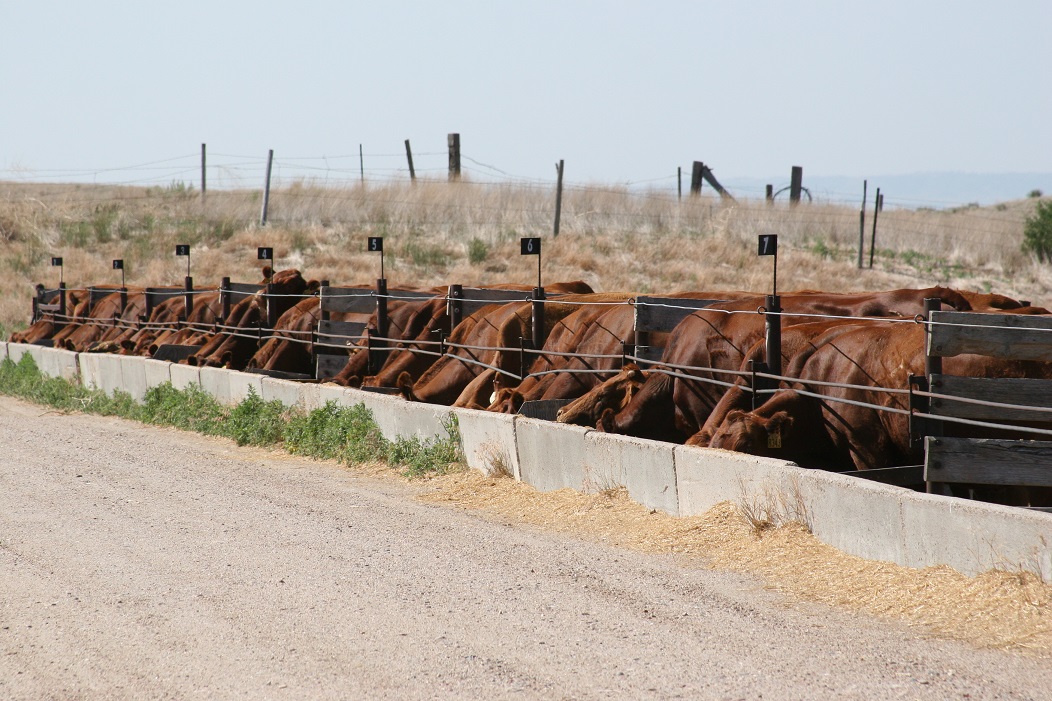
By Karla H. Jenkins, UNL Cow/Calf Specialist
As pasture rental rates continue to be historically high and pasture availability limited, many producers are evaluating confining production cows as an alternative to grazing. In many areas, by-products such as distillers grains, beet pulp, or wet corn gluten feed are the least cost feed available when priced per unit of total digestible nutrients (TDN). Additionally, crop residues such as wheat straw, bean straw, baled cornstalks, or low quality hay are often readily available and can be purchased less expensively than medium or high quality hay. Feeding high quality by-products with low quality forage often is more economical than feeding medium quality forage ad libitum. One of the key concepts to feeding production cows in confinement economically when using by-product feeds is to limit intake so costs are kept as reasonable as possible.
However, many producers have asked the question, “Do cattle have a dry matter intake requirement?” The answer is no. Cattle have a requirement for a certain amount of energy, protein and minerals depending on environmental conditions, stage of production and desired performance. Based on research, the Nutrient Requirements of Beef Cattle suggests the dry matter intake that can be expected given the digestibility of the feed required to achieve desired performance. This should not be confused with being a required dry matter intake.
Typically, with growing cattle, the producer wants cattle to eat as much as they can to get the nutrients needed to achieve the desired gain. But in this case as well, there is not a required dry matter intake, only intake of the nutrients necessary for the desired gain.
In the scenario of the confinement production cow, how little dry matter can be fed? This is a difficult question as it depends on the commodities being fed, the management style used, the cow’s requirements, and the comfort and well-being of the animal.
University of Nebraska research trials have typically limited 1300 pound gestating, non-lactating, confined cows to 1.5 to 1.8% of body weight on a dry matter basis without indications of discomfort from the cows. A management practice that improves cow comfort when limit feeding, is to establish a feeding routine and be consistent in the routine. If cows are fed only once a day, it is important to feed as close to the same time every day as possible and not drive feeding equipment past the cattle throughout the day if they are not being fed.
Once cows calve, are lactating, and calves start eating feed, limiting intake is more difficult. One solution is to allow calves access to a creep pen, feeder, or grazing that provides plenty of high quality feed without competing with limit fed cows. Even with calves having access to additional feed, the energy density or dry matter intake of the cows will need to increase to meet the additional demands of lactation.
Feeding cows in confinement can be an economical alternative to leasing grass if the cost of the diet can be minimized. For more information on limit fed rations and managing production cows in confinement, visit Beef.unl.edu. The NebGuide "Management Considerations for Beef Cows in Confinement" (http://extensionpublications.unl.edu/assets/pdf/g2237.pdf) along with other articles, videos and NebGuides are available through the website. If you would like assistance with developing and balancing a ration to meet the requirements of cows being fed in confinement, contact Nebraska Extension Beef Educators and Specialists.
To listen to BeefWatch podcasts go to: https://itunes.apple.com/us/podcast/unl-beefwatch/id964198047 or paste http://feeds.feedburner.com/unlbeefwatch into your podcast app.